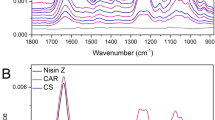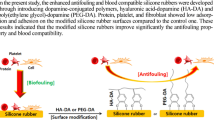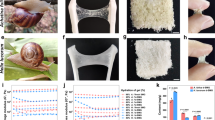Abstract
In this study, we aimed to develop polyelectrolyte multilayered films that could be absorbed onto a silicone rubber substrate; this composite material was then tested for its ability to inhibit bacterial adhesion. Polyacrylic acid (PAA) grafting onto the silicone rubber substrate was confirmed by attenuated total reflectance-infrared spectroscopy and the surface roughness of multilayered films was measured using an atomic force microscope and scanning electron microscopy. Immobilization of PAA, chitosan (CS) and heparin (HEP) films conferred antibacterial activity against Escherichia coli and Staphylococcus Aureus. The adhesion of both E. coli and S. aureus on PAA-CS-HEP multilayer film was reduced when compared to pristine, PAA, and PAA–CS films; this was due to effective complex formation between polyelectrolytes and cell adhesion proteins. Moreover, immobilization of HEP on the PAA-CS composite was efficiently reduced cell adhesion.







Similar content being viewed by others
References
Domka J, Lee J, Wood TK (2006) Ylih (BssR) and YceP (BssS) regulate escherichia coli k-12 biofilm formation by influencing cell signaling. Appl Environ Microbiol 72:2449–2459
Eun YJ, Weibel DB (2009) Fabrication of microbial biofilm arrays by geometric control of cell adhesion. Langmuir 25:4643–4654
Decher G (1997) Fuzzy nanoassemblies: toward layered polymeric multicomposites. Science 277:232–1237
Bertrand P, Jonas A, Laschewsky A, Legras R (2000) Ultrathin polymer coatings by complexation of polyelectrolytes at interfaces: suitable materials, structure and properties. Macromol Rapid Commun 21:319–348
Hammond PT (2004) Form and function in multilayer assembly: new applications at the nanoscale. Adv Mater 16:1271–1293
Jiang SY, Cao ZQ (2010) Ultralow-fouling functionalizable and hydrolyzable zwitterionic materials and their derivatives for biological applications. Adv Mater 22:920–932
Muzzarelli RAA (1977) Chitin. Pergamon Press, London
Smith RC, Riollano M, Leung A, Hammond PT (2009) Layer-by-layer platform technology for small-molecule delivery. Angew Chem Int Ed 48:8974–8977
Kim BS, Smith RC, Poon Z, Hammond PT (2009) MAD (Multiagent Delivery) Nanolayer: delivering multiple therapeutics from hierarchically assembled surface coatings. Langmuir 25:14086–14092
Popescu I, Suflet DM, Mihai M (2012) Influence of the comonomer structure and of the initial pH on the characteristics of polyelectrolyte complexes based on maleic acid copolymers. J Polym Res 19:9958
Liu H, Wu R, Du J, Nie X, Xu S, Wang J (2014) Fabrication of polyelectrolyte/amine-modified silica composite thin film by coupling of layer-by-layer assembly and sol–gel techniques. J Polym Res 21:328
Hong J, Wook Kang S (2011) Nano-container assembled thin films with time-programmed release of hydrophobic dyes. J Polym Res 18:2005–2009
Such GK, Johnston APR, Caruso F (2011) Engineered hydrogen-bonded polymer multilayers: from assembly to biomedical applications. Chem Soc Rev 40:19–29
Capila I, Linhardt RJ (2002) Heparin-protein interactions. Angew Chem Int Ed 41:391–412
Pavinatto FJ, Pavinatto A, Caseli L, dos Santos DS, Nobre TM, Zaniquelli MED, Oliveira ON (2007) Interaction of chitosan with cell membrane models at the air−water interface. Biomacromolecules 8:1633–1640
Lowman GM, Tokuhisa H, Lutkenhaus JL, Hammond PT (2004) Novel solid-state polymer electrolyte consisting of a porous layer-by-layer polyelectrolyte thin film and oligoethylene glycol. Langmuir 20:9791–9795
Rahimi N, Molin DG, Cleij TJ, van Zandvoort MA, Post MJ (2012) Electrosensitive polyacrylic acid/fibrin hydrogel facilitates cell seeding and alignment. Biomacromolecules 13:1448–1457
Yoo D, Shiratori SS, Rubner MF (1998) Controlling bilayer composition and surface wettability of sequentially adsorbed multilayers of weak polyelectrolytes. Macromolecules 31:4309–4318
Macdonald ML, Samuel RE, Shah NJ, Padera RF, Beben YM, Hammond PT (2011) Tissue integration of growth factor-eluting layer-by-layer polyelectrolyte multilayer coated implants. Biomaterials 32:1446–1453
Dalton BA, McFarland CD, Underwood PA, Steele JG (1995) Role of the heparin binding domain of fibronectin in attachment and spreading of human bone-derived cells. J Cell Sci 108:2083–2092
Lin H, Lal R, Clegg DO (2000) Imaging and mapping heparin-binding sites on single fibronectin molecules with atomic force microscopy. Biochemistry 39:3192–3196
Acknowledgments
The authors would like to thank the Armed Forces Taoyuan General Hospital (Project numbers: 10220) for financially supporting and opinions counseling in this work.
Author information
Authors and Affiliations
Corresponding author
Additional information
Yung-Zung Chang and Jing-Tang Lin contributed equally to this work.
Rights and permissions
About this article
Cite this article
Chang, YZ., Lin, JT., Prasannan, A. et al. Evaluation of the bacterial anti-adhesive properties of polyacrylic acid, chitosan and heparin-modified medical grade Silicone rubber substrate. J Polym Res 22, 131 (2015). https://doi.org/10.1007/s10965-015-0767-6
Received:
Accepted:
Published:
DOI: https://doi.org/10.1007/s10965-015-0767-6




